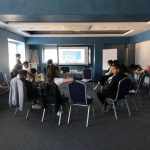impact
What has changed?
Two campaigns: “The problems of the Roma community in Blagoevgrad through the eyes of young people, presented with the Photovoice method” and “Check in advance, don’t trust! The truth from the life of the Roma ghetto in Dupnitza” provoke huge public interest.
Young people from American University in Bulgaria started active communication and joined initiatives with their mates from the two Roma districts in Blagoevgrad and Dupnitza. Together they made photos, videos and interviews to capture the problems and the stories of the most marginalized districts in both towns.
Photos and solutions to the problem were presented with exhibitions in both municipalities and in the lobby of the University. Through photovoice and storytelling techniques, exhibitions and social media they drew public attention and showed a great example how young people could have a voice by solving burning community issues.
Except for receiving some promises on behalf of the municipalities to manage the problems, the participants started changing attitudes of the people in both towns towards Roma young people, who want to change the current situation and live a different life.
-
evidence
What did you find out?
The results of a large-scale comparative study conducted among young people in Bulgaria (mainstream and Roma youth) show that difficulties accessing Sexual and Reproductive Health (SRH) information and services is due to: a) lack of trust in public institutions, b) confusion, caused by the spread of misinformation and fake news, c) the existing stigma in society and d) the lack of efficient and accessible national mental health policies and services. The data show significant difference between the difficulties and barriers mainstream youth face in comparison with young people from marginalized communities. Roma youth do not have equal access to quality SRH services and are not involved in the local decision-making process.What do you want to change?
We want to empower young people from Roma communities to participate actively in local community development and decision making by using methods of efficient campaigning and advocacy. We also want to strengthen their voice to change wrong practices, especially concerning the access to health and SRH services. Two advocacy campaigns in two Bulgarian municipalities: Blagoevgrad and Dupniza (middle and small size towns), were focused on provision of better health services to a most needed, better infrastructure (water supply, sanitation, etc.). The campaigns were initiated and leaded by Roma young activists. Using the Photo Voice methods, young people raised the problems with visual means (photos, videos) and formulated the solutions they want to see from their local authorities.How did you include people?
Bulgaria Family Planning Association (BFPA) has young volunteers and tries to involve them at all levels of organizational work, including all kind of initiatives – management, capacity building, awareness raising, campaigning, advocacy. At the same time, we work “on-the field” on many places with marginalized population together with the National Network of Health Mediators. BFPA is well known in the Roma communities with variety of initiatives. The preparation of the youth-let campaigns included capacity building education of mixed groups of young people – both mainstream and Roma young representatives. During the training young people work in small groups together to develop their own campaign ideas and to distribute each other roles.What did you enjoy?
Nedko, 18 years old, shared: “For a first time in my life I felt proud to be part of initiative, which helped my family, friends and community to see some positive changes in our ghetto. I was myself, communicated with young people of my generation, who study in prestigious Universities in Bulgaria and abroad. It makes me feel that I also have the chance to improve my life, I am not excluded, something depends on me…” -
advice
What do you recommend?
We recommend future initiatives/projects for Roma youth to include mainstream youth and to find the way to bridge interest of both groups to interact and work together. This could be the way of overcoming segregation and stigma. The Roma health mediator Katya Kirilova from Blagoevgrad told us “Many organizations are coming to work with our young people from the most marginalized district “Predel mahala” (the ghetto). They didn’t provoke the attention of our youth speaking to each other about the same and the same problems. What I saw during the initial capacity building training of BFPA is something, which I have not seen till now. Our Roma young people were shy at the beginning, because they never had the chance to be together and to be involved in joint initiatives with young people, who are studying in famous Universities in Bulgaria, Italy, USA and Austria. During the second day of the training they danced and discussed together and were inspired and motivated to participate in all activities during the campaign.” The interaction between young people from different social strata and ethnos is crucial for them to overcome the prejudices. The information and advocacy campaigns, designed and conducted together gave a unique message to the whole society.What advice would you give?
Inspiration and motivation of young people is a prerequisite for successful work. It is important to involve Roma youth in the whole process and give them the necessary knowledge and confidence to develop their own ideas. As mentioned above part of the success is also to empower them to work on the problems together with their mates from different schools and Universities and to feel equally represented in the process.



